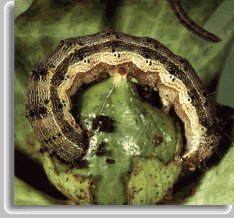
Tobacco budworm and corn earworm larvae are so similar in appearance that it is not possible to distinguish between them in the field.
Examine the buds for feeding damage and the small green to black worms. Treat if there are 5 or more live budworms per 50 plants. Do not count the plant as infested if you cannot find a budworm.
Budworms feed in the buds of young tobacco plants causing rounded holes in developing leaves. Tobacco plants may be topped by these pests resulting in early sucker growth.
The potential for budworm problems is greatest on early-set tobacco. Bacillus Thuringiensis baits have given excellent control of this insect in flue-cured areas but there are no efficient ways to apply baits to large acreages. BT sprays are most effective if applied when larvae are small and feeding actively. Use high rates for heavy populations.
| Insecticide | Rate/Acre | Harvest Interval (days) |
| Acephate | 2/3 lb | 3 |
| Bracket | 2/3 lb | 3 |
| Orthene 75 SP | 3/4 lb | 3 |
| Orthene 97 | 3/4 lb | 3 |
| Agree WG (3.8% Bt aizawai) | 1 to 2 lbs | 0 |
| Biobit HP (6.4% Bt kurstaki) | 1/2 to 1 lb | 0 |
| Denim 0.16 EC | 8 to 12 fl. oz. | 14 |
| Dipel 10 G (Bt kurstaki) | 5 to 10 lbs | 0 |
| Dipel DF (10% Bt kurstaki) | 1/2 to 1 lb | 0 |
| Dipel ES (3.5% Bt kurstaki) | 1 to 2 pts | 0 |
| Javelin - WG (7.5% Bt kurstaki) | 1/8 to 1-1/4 lbs | 0 |
| Lepinox WDG (15% Bt kurstaki) | 1 to 2 lbs | 0 |
| Golden Leaf Tobacco Spray | 2/3 to 1-1/3 qt | 5* |
| Lannate SP | 1/2 lb | 14 |
| Phaser 3E | 2/3 to 1-1/3 qt | 5* |
| Sevin 80S | 1-1/4 lbs | 0 |
| Tracer 4SC (spinosid A and D) | 1.4 to 2.9 fl oz* | 3 |
| Warrior 1 CS (lambda cyhalothrin) |
1.92 to 3.84 fl oz* | 40 |
| XenTari DF (10.3% Bt aizawai) | 1/2 to 2 lb | 0 |